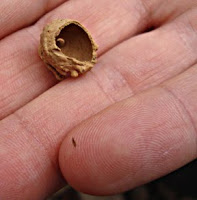Thursday, December 17, 2009
The Wasp's Pot
We were on the road to the wetlands atop Ruffner Mountain in Birmingham, Alabama this afternoon, when Peter Van Zandt pointed out a tiny mud pot attached to the stem of a dried plant.
Who "threw" this pot?
My first thought: maybe a relative of the mud dauber wasp.
It wasn't until I got home and searched bugguide.net that I found similar images. This pot was constructed by one of the 8 species of "Potter" wasps in the genus Eumenes, relatives of the Yellowjacket, Paper Wasp and Hornet.
The most common species in the east is Eumenes fraternus. Take a look at this webpage to see photos of what goes on inside inside the pot.
The female of these solitary wasps constructs the pots, one at a time, by mixing mud and hair. She'll often construct several of them, along a branch or stem.
Then she "provisions" them. She captures, anesthetizes and stuffs a couple of small caterpillars, usually cankerworms or sawfly larvae, into the pot. Then she lays a single egg in her pot and seals it with a mud plug. When the egg hatches, the larvae feed on the "provisions." The adult wasp escapes by chewing its way out through the mud wall.
There are two generations of this wasp each year - late spring to early fall. They over-winter in the pot and emerge as adults in the spring.
I've noticed wasps at my hummingbird feeders in the fall. Next year, I will pay closer attention. How many eggs does she lay? How long does it take her to "throw" a pot?
Subscribe to:
Post Comments (Atom)

No comments:
Post a Comment